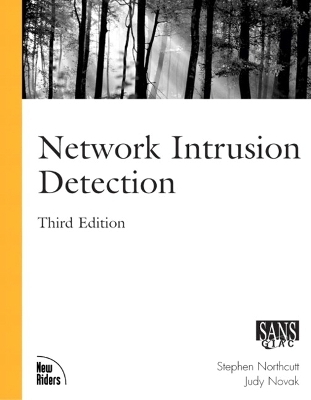
Network Intrusion Detection
New Riders Publishing (Verlag)
978-0-7357-1265-2 (ISBN)
- Keine Verlagsinformationen verfügbar
- Artikel merken
PLEASE PROVIDE
The Chief Information Warfare Officer for the entire United States teaches you how to protect your corporate network. This book is a training aid and reference for intrusion detection analysts. While the authors refer to research and theory, they focus their attention on providing practical information. The authors are literally the most recognized names in this specialized field, with unparalleled experience in defending our country's government and military computer networks. New to this edition is coverage of packet dissection, IP datagram fields, forensics, and snort filters.
About the Authors Stephen Northcutt is a graduate of Mary Washington College. Beforeentering the field of computer security, he worked as a Navy helicopter searchand rescue crewman, white water raft guide, chef, martial arts instructor,cartographer, and network designer. Stephen is author/co-author of IncidentHandling Step by Step, Intrusion Signatures and Analysis, Inside NetworkPerimeter Security, and the previous two editions of this book. He was theoriginal author of the Shadow intrusion detection system and leader of theDepartment of Defense's Shadow Intrusion Detection team before acceptingthe position of Chief for Information Warfare at the Ballistic Missile DefenseOrganization. Stephen currently serves as Director of Training and Certificationfor the SANS Institute. Judy Novak is currently a senior security analyst working for theBaltimore-based consulting firm of Jacob and Sundstrom, Inc. She primarily worksat the Johns Hopkins University Applied Physics Laboratory where she is involvedin intrusion detection and traffic monitoring and Information Operationsresearch. Judy was one of the founding members of the Army Research LabsComputer Incident Response Team where she worked for three years. She hascontributed to the development of a SANS course in TCP/IP and written a SANShands-on course, "Network Traffic Analysis Using tcpdump," both ofwhich are used in SANS certifications tracks. Judy is a graduate of theUniversity of Maryland—home of the 2002 NCAA basketball champions. She isan aging, yet still passionate, bicyclist, and Lance Armstrong is her modern-dayhero! © Copyright Pearson Education. All rights reserved.
(NOTE: Each chapter concludes with a Summary.) I. TCP/IP.
1. IP Concepts.
The TCP/IP Internet Model. Packaging (Beyond Paper or Plastic). Addresses. Service Ports. IP Protocols. Domain Name System. Routing: How You Get There from Here.
2. Introduction to TCPdump and TCP.
TCPdump. Introduction to TCP. TCP Gone Awry.
3. Fragmentation.
Theory of Fragmentation. Malicious Fragmentation.
4. ICMP.
ICMP Theory. Mapping Techniques. Normal ICMP Activity. Malicious ICMP Activity. To Block or Not to Block.
5. Stimulus and Response.
The Expected. Protocol Benders. Abnormal Stimuli.
6. DNS.
Back to Basics: DNS Theory. Using DNS for Reconnaissance. Tainting DNS Responses.
II. TRAFFIC ANALYSIS.
7. Packet Dissection Using TCPdump.
Why Learn to Do Packet Dissection? Sidestep DNS Queries. Introduction to Packet Dissection Using TCPdump. Where Does the IP Stop and the Embedded Protocol Begin? Other Length Fields. Increasing the Snaplen. Dissecting the Whole Packet. Freeware Tools for Packet Dissection.
8. Examining IP Header Fields.
Insertion and Evasion Attacks. IP Header Fields. The More Fragments (MF) Flag.
9. Examining Embedded Protocol Header Fields.
TCP. UDP. ICMP.
10. Real-World Analysis.
You've Been Hacked! Netbus Scan. How Slow Can you Go? RingZero Worm.
11. Mystery Traffic.
The Event in a Nutshell. The Traffic. DDoS or Scan. Fingerprinting Participant Hosts.
III. FILTERS/RULES FOR NETWORK MONITORING.
12. Writing TCPdump Filters.
The Mechanics of Writing TCPdump Filters. Bit Masking. TCPdump IP Filters. TCPdump UDP Filters. TCPdump TCP Filters.
13. Introduction to Snort and Snort Rules.
An Overview of Running Snort. Snort Rules.
14. Snort Rules-Part II.
Format of Snort Options. Rule Options. Putting It All Together.
IV. INTRUSION INFRASTRUCTURE.
15. Mitnick Attack.
Exploiting TCP. Detecting the Mitnick Attack. Network-Based Intrusion-Detection Systems. Host-Based Intrusion-Detection Systems. Preventing the Mitnick Attack.
16. Architectural Issues.
Events of Interest. Limits to Observation. Low-Hanging Fruit Paradigm. Human Factors Limit Detects. Severity. Countermeasures. Calculating Severity. Sensor Placement. Outside Firewall. Push/Pull. Analyst Console. Host- or Network-Based Intrusion Detection.
17. Organizational Issues.
Organizational Security Model. Defining Risk. Risk. Defining the Threat. Risk Management Is Dollar Driven. How Risky Is a Risk?
18. Automated and Manual Response.
Automated Response. Honeypot. Manual Response.
19. Business Case for Intrusion Detection.
Part One: Management Issues. Part Two: Threats and Vulnerabilities. Part Three: Tradeoffs and Recommended Solution. Repeat the Executive
20. Future Directions.
Increasing Threat. Defending Against the Threat. Defense in Depth. Emerging Techniques.
V. APPENDIXES.
Appendix A. Exploits and Scans to Apply Exploits.
False Positives. IMAP Exploits. Scans to Apply Exploits. Single Exploit, Portmap. Summary.
Appendix B. Denial of Service.
Brute-Force Denial-of-Service Traces. Elegant Kills. nmap. Distributed Denial-of-Service Attacks. Summary.
Appendix Ctection of Intelligence Gathering.
Network and Host Mapping. NetBIOS-Specific Traces. Stealth Attacks. Measuring Response Time. Worms as Information Gatherers. Summary.
Index
| Erscheint lt. Verlag | 4.9.2002 |
|---|---|
| Sprache | englisch |
| Maße | 180 x 230 mm |
| Gewicht | 802 g |
| Themenwelt | Informatik ► Netzwerke ► Sicherheit / Firewall |
| ISBN-10 | 0-7357-1265-4 / 0735712654 |
| ISBN-13 | 978-0-7357-1265-2 / 9780735712652 |
| Zustand | Neuware |
| Haben Sie eine Frage zum Produkt? |
aus dem Bereich


